Pieris

This is a Spring morning….Out of the southwest comes the wind in puffs and lulls…
– Charles Burchfield
While this month’s winds may conjure up spring to some, our landscape still broadly reads of winter’s arboreal bareness. Fortunately, our eyes may find soothing fixation on various evergreen trees, shrubs or groundcovers, as well as on early flowering bulbs and witch hazels. Previously we have reviewed evergreen shrubs such as boxwoods, yews, and long stalk hollies. Herein we sing the praises of the ornamental, evergreen shrubs, belonging to the genus Pieris. Having only seven species, this small genus is within the ERICACEAE, or heath and heather family, a large family with 120 genera and over 4000 species, which also includes rhododendron, mountain laurel, blueberry, cranberry, sourwood and leucothoe, among others found growing within our landscape. Pieris is derived from Piera, located at the northern foot of Mount Olympus, and in Greek mythology was the home of the nine Muses, the goddesses of inspiration of literature, science and arts.
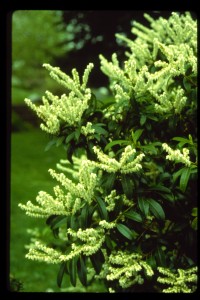
Two girls discover
the secret of life
in a sudden line of
poetry.
I who don’t know the
secret wrote
the line…
Denise Levertov
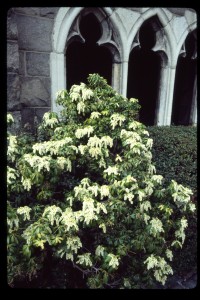
Pieris floribunda, Mountain andromeda’s common name is, for botanists slightly confusing, because Andromeda is actually another small genus of evergreen shrubs also found in the ERICACEAE. We here are reminded of other confusions found with plants’ scientific and common names. Red cedar (Juniperus) is not a cedar (Cedrus). Tulip poplar (Liriodendron) is not a poplar (Populus). Mountain ash (Sorbus) is not an ash (Fraxinus). Blue beech (Carpinus) is not a beech (Fagus). Nonetheless Pieris floribunda, native to the high mountains of Virginia and Tennessee south to Georgia, are 2-6-foot-tall shrubs, with dark green, 1-3-inch-long, evergreen leaves. 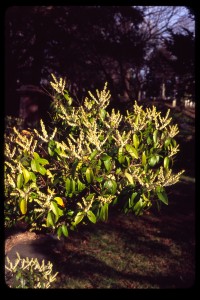 Here briefly excerpted from Stephen Spongberg’s fascinating 1990 book A Reunion of Trees is a recounting of its introduction, “John Lyon (1765-1814) discovered…on September 16, 1807, when he climbed Pilot Mountain, an isolated monadnock on the upper Piedmont northwest of Winston-Salem in Surrey County, North Carolina…Lyon had immigrated to the United States…this Scotsman undertook botanical and horticultural exploration of the new nation…” This plant’s abundant, white, fragrant flowers appear in April on dense, erect 2-4-inch-long panicles, making a strong contrast to the handsome foliage. Eighty-six Mountain andromeda are growing throughout the grounds, according to our most recent Plant Inventory.
Here briefly excerpted from Stephen Spongberg’s fascinating 1990 book A Reunion of Trees is a recounting of its introduction, “John Lyon (1765-1814) discovered…on September 16, 1807, when he climbed Pilot Mountain, an isolated monadnock on the upper Piedmont northwest of Winston-Salem in Surrey County, North Carolina…Lyon had immigrated to the United States…this Scotsman undertook botanical and horticultural exploration of the new nation…” This plant’s abundant, white, fragrant flowers appear in April on dense, erect 2-4-inch-long panicles, making a strong contrast to the handsome foliage. Eighty-six Mountain andromeda are growing throughout the grounds, according to our most recent Plant Inventory.
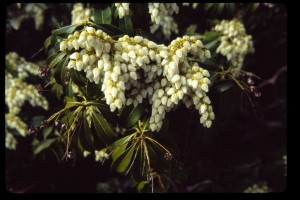 Pieris japonica, Japanese Andromeda, native to Japan was introduced into horticultural use in the 1870’s. This species has a taller, 9-12-feet-high, upright habit, also with evergreen leaves. The white, slightly fragrant flowers, occurring sometimes in late March, and persisting well into April, are arranged on distinctly pendulous panicles. The emerging new leaves often have a reddish or bronze color, before turning green at maturity. In Japan, wood from these shrubs are used as alcove posts (toko bashira) in traditional Japanese tea rooms. Over 150 Japanese Andromeda shrubs (including cultivated varieties) were listed in our current Plant Inventory.
Pieris japonica, Japanese Andromeda, native to Japan was introduced into horticultural use in the 1870’s. This species has a taller, 9-12-feet-high, upright habit, also with evergreen leaves. The white, slightly fragrant flowers, occurring sometimes in late March, and persisting well into April, are arranged on distinctly pendulous panicles. The emerging new leaves often have a reddish or bronze color, before turning green at maturity. In Japan, wood from these shrubs are used as alcove posts (toko bashira) in traditional Japanese tea rooms. Over 150 Japanese Andromeda shrubs (including cultivated varieties) were listed in our current Plant Inventory.
A notable hybrid cross between Japanese Andromeda and Mountain Andromeda named Pieris xBrouwer’s Beauty has distinct red unopened flower buds, adding dramatic color to any winter landscape. We grow more than 40 Pieris xBrouwer’s Beauty throughout our landscape.
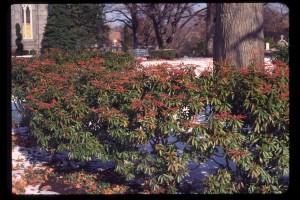
I was securing the pin in the diaper
when someone banged on the door
and it was this guy
in an orange fishnet Florida Interstate
T-shirt
holding his bike helmet and saying
Hi, I’m the muse.
You?…
George Ella Lyon
~
Leave a Reply